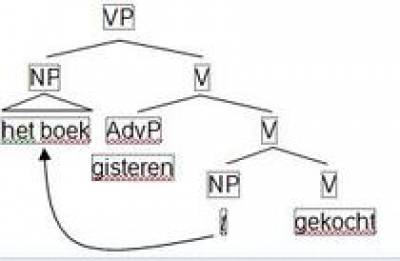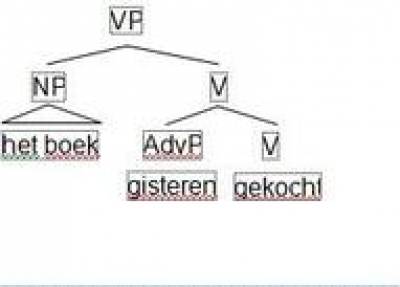Research Questions
Word-order alternations may
signal the status of certain phrases in an unfolding discourse.
Here we
investigate the structure of sentences in which a discourse-given constituent
appears in an earlier position in the sentence than it normally would.
This word-order alternation, known as neutral scrambling (NS), is exemplified in the Dutch examples below.
| (1) | a. | Marie | heeft | gisteren | het | boek | gekocht. | |
| Mary | has | yesterday | the | book | bought | |||
| b. | Marie | heeft | het | boek | gisteren | gekocht. | ||
| Mary | has | the | book | yesterday | bought | |||
|
`Mary |
has |
bought |
the |
book |
yesterday' |
In (1a), where 'het boek' (the book) follows 'gisteren' (yesterday), this phrase is interpreted as new information, whereas the order in (1b) requires previous mention of 'the book'.
Our primary objective is to uncover empirical evidence that would allow us to choose between two competing analyses of NS.
On the first analysis, (1b)
is derived from (1a) by ‘movement’, an operation which leaves behind a ‘trace’
(an unpronounced copy) of the moved constituent, as in (2a).
On the second,
(1a) and (1b) are not related by movement, but differ in how their basic
structures are built: in (1a) 'het boek' combines with the verb to form a
constituent after which 'gisteren' combines with that constituent to create a
yet larger constituent, whereas in (1b) 'het boek' and 'gisteren' combine with
the verb in the opposite order, as in (2b).
On this second analysis, there is no trace of 'het boek' between 'gisteren' and the verb.
| (2) | a. |
 |
b. |
 |
Research question: Does NS involve movement?
Natural languages differ in the extent to which
they permit NS.
Dutch is representative of a class of languages in which a
discourse-given argument (a subject, object or
indirect object) may undergo NS
across an adjunct (or modifier) but
not across another argument.
German is representative of
a second class of languages, in which NS is
freer and may give rise to reordering of arguments.
This variation is potentially very relevant to the choice between a movement and a base-generation analysis.
There is a strong
cross-linguistic generalization, the thematic hierarchy, concerning the mapping
between semantic roles (agent, theme, etc.) and their structural realization.
For example, an agent is invariably realized higher in the syntactic structure
than a theme.
A base-generation analysis of NS across an adjunct gives rise to
structures that respect the thematic hierarchy.
By contrast, a base-generation
analysis of NS across an argument would imply that the syntactic realization of
arguments may violate this hierarchy under appropriate discourse conditions.
This being the case, we should investigate the possibility that these two variants of NS do not yield to the same analysis and split the general question posed above into two subquestions, to be investigated separately:
Subquestion 1: Does NS across an adjunct involve syntactic movement?
Subquestion 2: Does NS across an argument involve syntactic movement?
 Close
Close

